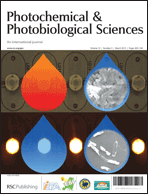Peptide nanostructures have recently been identified as an important bio-functional nanostructure. Researchers have demonstrated that modification of these peptide nanostructures can greatly expand their biological applications.
 In this work, Minjoong Yoon and colleagues from Chungnam National University, Republic of Korea, have prepared peptide nanoribbons (PNRs) impregnated with a Sn-porphyrin via solvothermal self-assembly. The resulting nanoribbons are highly fluorescent and thermo-stable. However, the fluorescence intensity and life-time were selectively affected upon interaction with the nucleotide base sequences of DNA, thus implying that these Sn-porphyrin-PNRs could be useful as a biocompatible DNA sensor.
In this work, Minjoong Yoon and colleagues from Chungnam National University, Republic of Korea, have prepared peptide nanoribbons (PNRs) impregnated with a Sn-porphyrin via solvothermal self-assembly. The resulting nanoribbons are highly fluorescent and thermo-stable. However, the fluorescence intensity and life-time were selectively affected upon interaction with the nucleotide base sequences of DNA, thus implying that these Sn-porphyrin-PNRs could be useful as a biocompatible DNA sensor.
Read the full article for free until the 7th March 2013!
Highly fluorescent peptide nanoribbon impregnated with Sn-porphyrin as a potent DNA sensor, Sreenivasan Koliyat Parayil, Jooran Lee and Minjoong Yoon, Photochem. Photobiol. Sci., 2013, DOI: 10.1039/C3PP25337F
Keep up to date with the latest developments from Photochemical & Photobiological Sciences by signing up for free table of contents alerts.












